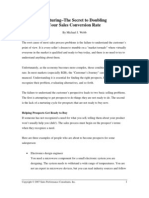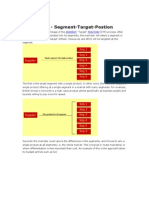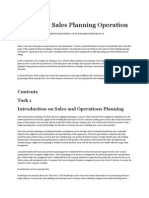Mathmarketing™ How To Make Your Sales & Marketing Count For More
Mathmarketing™ How To Make Your Sales & Marketing Count For More
Uploaded by
Brett BonserCopyright:
Available Formats
Mathmarketing™ How To Make Your Sales & Marketing Count For More
Mathmarketing™ How To Make Your Sales & Marketing Count For More
Uploaded by
Brett BonserOriginal Title
Copyright
Available Formats
Share this document
Did you find this document useful?
Is this content inappropriate?
Copyright:
Available Formats
Mathmarketing™ How To Make Your Sales & Marketing Count For More
Mathmarketing™ How To Make Your Sales & Marketing Count For More
Uploaded by
Brett BonserCopyright:
Available Formats
Can you get blood from a stone?
Your Marketing and Sales functions are peddling as fast as they can. Marketing
are busy running campaigns and events to create awareness of your brand and
to create leads. Sales are busy pitching to prospects, proposing solutions and
closing.
Despite your earnest belief in the effectiveness of your Marketing and Sales
organisations, your success is still largely dictated by the whims of the market.
When expenditure in your product market is growing, provided you are "in
amongst it" your business grows too. Equally, when the market contracts, so
MathMarketing™ does your revenue.
Nonetheless, growth in revenue is as possible in a flat market as in a buoyant
How to make your one. A company that enjoys 10% market share need only extract an additional
2% market share to achieve 20% revenue growth in a flat market. Clearly for
sales & marketing you to win, someone else has to lose, but how?
count for more Sales methodologies abound. Most are very good, and to the extent that the
most appropriate ones have been well implemented within your company, they
have significantly improved your account planning and sales execution to a
measurable degree.
But you know you can get more out of the market. In this paper I’ll spell out a
framework which explains how the Sales and Marketing functions of the best
run companies align and structure their activities to prosecute the market
opportunity better than their competitors, without abandoning their proven sales
methodologies.
Page 1 MathMarketing - Funnel Summary
Funnel summary.doc 20 May 2003
WHERE DOES THE PROBLEM LIE?
Four anchors
Our customers (and their customers) have taught us a great deal. In consulting
to large and small companies in the IT&T (Information Technology and
Telecommunications) industry we have completed over 140 strategy
assignments at the time of writing. In this work, and the research interviews
with business buyers of products and services conducted on behalf of these
customers, we have found a number of common inhibitors to optimal
effectiveness. Four of these relate to the way Sales and Marketing plan the
execution of the strategy. We call these the “four anchors” because any one of
them on their own can slow the whole sales / marketing process.
1. Marketing and Sales are on different planets. Despite their individual
effectiveness, the functions of Marketing and sales are not aligned,
especially in four areas:
Marketing and sales are communicating different messages
Leads generated by Marketing are not well qualified and are ignored.
Marketing campaign planning ignores the sales process.
Sales plan their own campaigns which ignore the marketing process.
The same customer is often contacted by both Marketing and Sales.
2. The indicators are way too late. By the time the sales forecasts are
looking flat, the problem has already existed for six months or even more.
3. The buying process is ignored. The marketing processes, the sales
processes, and the confused aggregate, often bare little resemblance to the
process of the business buyer.
4. Tactics are arbitrary. Communications tactics (including advertising, PR,
events, seminars, newsletters etc) are selected for historical reasons.
What about the bigger issues?
The core strategy is fundamental to get right, but this paper has been written for
those who are committed to their strategy and want to execute it optimally.
Having said that, we have found that either the absence of clarity or the
absence of conviction regarding three aspects of an organisation’s core strategy
will inevitably compromise the ability of staff to implement it.
Purpose and ideology
Target market; and
Positioning.
Page 2 MathMarketing - Funnel Summary
Funnel summary.doc 20 May 2003
So what is needed?
You need a framework which allows you to:
Be clear about the progression you are asking the buyers as a group to
make, and orchestrate that progression en masse.
Plan a single, integrated Sales and Marketing approach to the market.
Confidently select the optimal tactics and discard others.
Model realistic success based on well-established benchmarks
Measure and track the actual success of the coordinated efforts against
those benchmarks
Using these results, identify which phase in the mapped-out progression
presents the greatest opportunity for improvement.
Introducing MathMarketing™
MathMarketing™ is an approach to acquiring clients comprising three steps:
1. Identify what optimum momentum can look like for you:
Map out in detail the progression you wish to achieve in the mind of the
prospects as a group, from one clearly articulated belief to a second, then a
third and so-on, beginning with “who are you anyway” and ending with “that
worked well, I’d like to discuss another need with you”.
Dimension this progression to show how many prospects you expect to
successfully graduate from each phase to the next, allowing for realistic
success rates for each phase and the time it would take to achieve this
progression for each phase.
Consciously increase or decrease the number of prospects targeted in the
early stages of this progression over time to ensure resources are optimally
deployed.
2. Develop a plan to achieve that momentum
Select the optimal tactics for each phase, and task these tactics narrowly to
achieve the graduation of this phase, not some broader, but loosely defined
marketing objective like “brand awareness” or sales objective like “create
opportunities”.
Break these tasks down into those required once, for set up, and those
which must be done every day / week /month.
3. Measure results and adjust as required
Measure actual results, benchmark these results against other, like
companies, and adjust the tactics or their implementation as required.
The visualisation used to describe this mass progression with loss at each
stage is a funnel – the MathMarketing™ funnel.
Page 3 MathMarketing - Funnel Summary
Funnel summary.doc 20 May 2003
The “leaky” funnel
The concept of a sales funnel is well understood and widely used in most sales
Suspects organizations. The basic sales funnel is a good starting point towards
understanding the MathMarketing™ funnel, but it has many weaknesses:
Prospects The journey from the top to the bottom can often take longer, and traverse
more phases than is implied by a simple funnel.
Marketing’s role is to achieve outcomes not associated with the sales
Best few
funnel, which exacerbates the misalignment between the Sales and
Marketing functions.
There is no relationship between the sales funnel and the buying process of
a typical business.
The funnel does not reinforce your sales methodologies.
The funnel leaks. In using the funnel as a metaphor, we need to be mindful
that unlike a real funnel, the sales funnel has holes. You end up with fewer
prospects at the bottom than at the top because prospects fail to progress
from one phase to the next. In even the most effective sales and marketing
organizations, the total " leakage" will usually amount to more than 75% of
the total prospect pool that they began with, yet the planning in most
organisations is about dealing only with those who remain (the 25%).
From the research used in over 140 strategy projects conducted in Australia, we
have found there to be between 9 and 12 discrete phases involved in the
journey from the top of the funnel (where the vendor is unknown to the
prospect) to the bottom (where they are a satisfied customer returning for
more). We have found it useful to describe these phases in terms of the
progression you are asking the buyers to make during each phase.
MathMarketing What do we want the prospect to think when this phase concludes?
"You are one of the companies I recognise as members of this
Position in category
product category."
"I have a problem which members of this product category can
Identify problem
probably solve, and you seem to understand that problem."
This is an internal-only phase, where the leads generated are
Qualify & Prioritise
evaluated agains some established criteria.
"You are a credible provider in this product category, and I
Establish Credentials
understand something of your unique selling proposition."
"I have a clearly defined need (problem or opportunity), and can
Define Need
articulate the payoff available to me for addressing this problem."
"I can see how your proposed solution might meet my needs and
Propose Solution
provide the payoff I seek."
"I can see how your proposed solution would work in my
Prove Concept
organisation, as outlined in your proposal."
Defeat Competition "Your solution is the only one I want to consider."
Obtain Mgmt "My upline approvers and other stake-holders support my
Approval recommendation to accept your proposal."
Obtain Contract "You and I have a firm agreement binding us both."
Deliver "Your solution worked as promised, and I am pleased."
Grow "I have further needs I am interested in discussing with you."
Page 4 MathMarketing - Funnel Summary
Funnel summary.doc 20 May 2003
Mindful of what you want the prospect to think at the conclusion of each phase,
how can you best progress them from one belief to the next? To begin, take all
the tactics used by your sales and marketing organisations today, and set them
to one side. Beginning with a clean slate, the questions to ask become:
“With 5000 prospects identified, what tactic or tactics will be most effective
in having 1000 of them recognize us as a member of the product category?”
Then:
“With 1000 prospects recognizing us as a member of the product category,
what tactic or tactics will be most effective in having 500 of them recognize
they have a problem that we and other members of this category could
probably solve, and that we understand this problem?”
Then, assuming that 400 of the 500 meet our qualification criteria:
“With 400 prospects acknowledging a problem that we and others could
probably solve, and that we seem to understand, what tactic or tactics will
be most effective in having 200 of them recognize us as a credible provider
in this product category, and understand something of our unique selling
proposition?”
And so on to the bottom of the funnel. Before the tactics are crafted though,
you need to understand how many you need to work through the funnel to meet
our objectives. This is the Math, of MathMarketing™.
The “Math” of MathMarketing™
Most marketers can tell you what results should be expected from a direct
marketing campaign (2%), and most sales people can tell you their closure rate
(perhaps 30%). Yet these “proven truths” are neither proven, nor truths.
The results enjoyed by a direct marketing campaign can vary from literally 0%
to 100%, and vary widely from the oft-quoted 2% more often than they meet it.
Further, when the process is broken down into the MathMarketing™ phases, an
assessment of recorded results reveals useful insights. I’ll get to that soon.
Lets first lay the whole picture of the math of marketing out on the table.
Progressive leakage
For each phase in the MathMarketing™ funnel, a prediction should be made
regarding what percentage of those who have progressed to the current stage
will successfully be promoted to the next.
In the fictitious example below, I have estimated the predicted success for each
phase in the MathMarketing™ funnel. Commencing with 5000 names, I have
forecast to be successfully positioned as a member of the category with 30%
(1500). I am further predicting that we will successfully have 50% of these
(750) acknowledge that they have a problem. And so on down the funnel
resulting in 50 successful deliveries.
Page 5 MathMarketing - Funnel Summary
Funnel summary.doc 20 May 2003
Math Marketing Yield Q1 Q2 Q3 Q4 Q5 Q6 Q7 Q8 Yr3 Total
Position in category 30% 1500 0 0 0 0 0 0 0 0 1500
Identify problem 50% 750 0 0 0 0 0 0 0 0 750
Qualify & Prioritise 80% 600 0 0 0 0 0 0 0 0 600
Establish Credentials 30% 180 0 0 0 0 0 0 0 0 180
Define Need 75% 135 0 0 0 0 0 0 0 0 135
Propose Solution 95% 128 0 0 0 0 0 0 0 0 128
Prove Concept 80% 103 0 0 0 0 0 0 0 0 103
Defeat Competition 80% 82 0 0 0 0 0 0 0 0 82
Obtain Mgmt
80% 66 0 0 0 0 0 0 0 0 66
Approval
Obtain Contract 80% 53 0 0 0 0 0 0 0 0 53
Deliver 95% 50 0 0 0 0 0 0 0 0 50
Grow 75% 37 0 0 0 0 0 0 0 0 37
$2,495 $0 $0 $0 $0 $0 $0 $0 $0 $2,495
Not so fast
In the previous example, I overly simplified the funnel by assuming each phase
took no time at all. Once I allow for the time required to successfully progress
the required population from each phase to the next, the funnel can be more
accurately dimensioned. It has been our practice to look at the first two years
broken down into eight quarters, plus a third year.
A repeat dose?
I have described the advance sought from the “Grow” phase as a customer who
presents as “ready to discuss a new need”. Note that there is no assumption
yet that I can successfully identify and define a new need which warrants a
remedy, only that were one to emerge, they would be pleased to discuss it with
us. Accordingly, customers who successfully graduate the “Grow” phase,
should re-enter the MathMarketing™ funnel at the “Define Needs” phase after
having been subjected to the standard yield for this phase.
Dealing with the leakage
Earlier in this paper I mentioned that the funnel leaks. The MathMarketing™
funnel is no different. At each phase, prospects successfully graduate, but
many also fail. This “leakage” is usually left on the floor until it disappears (or
“evaporates”). At the risk of stretching the metaphor, the alternative to leaving
this leakage to evaporate is to “recycle” it.
Page 6 MathMarketing - Funnel Summary
Funnel summary.doc 20 May 2003
The further a prospect travels down the funnel, the greater has been your
investment to get them there.
My strategy for this prospect, and all others at the same stage, should be to
provoke a new need which I can earn the right to solve. The recycling strategy
should pick up leakage from all phases up to and including “Establish
Credentials” and begin the campaign again endeavouring to “Position in
Category”. All those who leak from phases “Define Need” and below should be
recycled back to “Define Need”.
The effect of recycling prospects is enormous. Failure to achieve graduation
from a phase after one attempt does not mean I had no affect; it means I had
insufficient affect. A second attempt reinforces the message I attempted to
convey on the first attempt and will cause some of the remainder to advance to
the next phase.
Tweaking for resource load
By phasing the introduction of the 5000 names into the top of the funnel rather
than putting them all in at once, the same number of prospects can produce
very similar revenues, but with a significantly more efficient sales force.
Clearly this is a more profitable approach, and one less likely to produce the
situation that prospects get “burned” by warming them up before I am ready to
deal with them.
The MathMarketing™ funnel which emerges as a result of these multiple
iterations might look something like the following
Weeks Math Marketing Yield Q1 Q2 Q3 Q4 Q5 Q6 Q7 Q8 Yr3 Total
4 Position in category 30% 521 460 259 375 353 349 348 305 398 3369
4 Identify problem 50% 260 222 124 188 177 175 174 153 208 1680
1 Qualify & Prioritise 80% 208 147 99 164 137 140 140 122 184 1340
3 Establish Credentials 30% 63 44 30 49 41 42 42 37 55 402
2 Define Need 75% 0 47 69 50 48 52 52 51 115 484
1 Propose Solution 95% 0 45 65 47 46 50 50 49 109 460
1 Prove Concept 80% 0 36 52 36 36 40 40 39 88 368
1 Defeat Competition 80% 0 29 39 28 30 33 31 31 72 293
Obtain Mgmt
2 80% 0 23 31 21 24 26 25 25 58 234
Approval
2 Obtain Contract 80% 0 18 21 17 21 20 20 20 49 186
4 Deliver 95% 0 17 17 16 21 19 19 19 48 176
6 Grow 75% 0 0 13 18 12 14 15 14 43 129
$0 $866 $826 $776 $1,075 $937 $938 $960 $2,397 $8,775
Figure 1 - The MathMarketing™ funnel indicates quarterly measurable
objectives for progression from each phase, each quarter.
Page 7 MathMarketing - Funnel Summary
Funnel summary.doc 20 May 2003
This iterative planning makes clear the number of progressions I need through
each phase, each quarter. It dimensions clearly what I must achieve. Only
now, with this clarity, should I consider how to achieve this outcome.
Optimal tactics for optimal momentum
The tactics necessary to achieve the objectives set for each phase can now be
identified. Whilst there may be good logic behind the choice of the current
communication tactics, it is usually easier to set them aside and begin from
afresh. Rather than asking the question "what should we do with our event
marketing?", the question should be "what would it take to get 260 prospects to
identify problems this quarter out of the 521 who have currently established
their interest assuming an average lag of 4 weeks?".
The tactics need to be selected to deliver the narrow objective of the phase, yet
recognising that later phases follow and the prospect should graduate one
phase ready to graduate the next.
Planning for failure
As you know, the funnel leaks.
MathMarketing It can leak at every stage, even
Establish Credentials. You can
contact a “hot” prospect and still
be declined a meeting, or have
it cancelled and not
rescheduled. Or you can have
a meeting with a prospect but
not get off first base. Most
leakage (failures) from any of
these first three phases can be
attributable to one thing: you
have failed to stimulate concern
about a problem that warrants
discussion. So, the leakage
strategy is to recycle all failures
from these first phases back to
“Establish Problem”.
Put them back in the pot and
cook them a little more.
Failure in the Define Needs
phase is more common than
might be expected. Many sales
calls end with a polite “thanks,
but no thanks” because no burning need has been established. Failure at later
phases (Propose Solution, Defeat Competition etc) are usually attributable to
one of only three causes:
the need did not justify the solution offered;
the solution offered did not meet the need or provide the payoff, or
an alternative solution met the need more fully.
Either way, nothing can happen until you have another need you can have a go
at solving. Treating leaked prospects who have come this far as strangers is
wasteful for you and discourteous to them. The leakage strategy for all
Page 8 MathMarketing - Funnel Summary
Funnel summary.doc 20 May 2003
prospects who fail at the Defined Need phase or any phase that follows is
therefore the same: define a new need.
There are some tactics which can help. Initiating a new sales call is fairly low
yield (“didn’t we cover this last time?”), but not entirely without merit. Assuming
that the leakage from these lower-funnel phases comprises a reasonable
population, preparing special presentations or white papers which create
deeper clarity about a problem and endeavour to tease out its implications can
yield significant results.
Prospects at this point know you are a credible provider and that your
representative is also OK. The task with these presentations and white papers
is to sell the problem and its implications, not your ability to address them.
Presentations, especially if the speaker has some professional standing, are a
great way to get back into previously unyielding prospects.
Page 9 MathMarketing - Funnel Summary
Funnel summary.doc 20 May 2003
ACKNOWLEDGEMENTS
No idea is entirely original, and MathMarketing™ is no exception. Of what I
presented in this paper, our clients taught us one third, and their clients taught
us another third. I thank both for their contribution and for letting us learn with
them. The remainder came from some other smart people who share our belief
that an idea is not valuable until it has been beaten about a bit, then shared
widely. Amongst this last group I include:
Mary & Mike Molloy from TRB consulting who through their book “The Buck
Starts Here”, and in some workshops I organised in 1997, first introduced
(to us at least) the idea of a progressive, granular sales/marketing process
that ought to be forecast and measured.
Neil Rackham from Huthwaite Inc who through his book “SPIN Selling”
presented a clear, well researched view of the process used by successful
sales people to effect progression via discrete and pre-defined advances in
the mind of a business buyer.
Alice M Tybout and Brian Sternthal from Kellogg University who in “Kellogg
on Marketing” stripped the fluff from market positioning to leave a believable
and usable core.
I am interested in your success. Any feedback regarding your business, its
challenges, your successes and failures and the way this paper has been
crafted would be welcome.
MathMarketing retains full copyright to the process, its articulation and
presentation. Nonetheless, we believe any belief only holds value if it is shared
widely. Accordingly, you are free to use this document without the need to seek
permission, and may reference it in other works. Our only condition is that
every time you do, you acknowledge MathMarketing as the source and that you
use its correct name (MathMarketing™) in referring to the process.
Hugh Macfarlane
Managing Partner
MathMarketing
PO Box 6146 St Kilda Road Central
Melbourne VIC 8008
Australia
+61 3 9690 7600
hmacfarlane@mathmarketing.com
www.mathmarketing.com
Page 10 MathMarketing - Funnel Summary
Funnel summary.doc 20 May 2003
You might also like
- Hypnotherapy For Dummies Cheat Sheet - For DummiesDocument4 pagesHypnotherapy For Dummies Cheat Sheet - For Dummiesnguyenhavn100% (1)
- Build Skills To Learn Faster and Better According To NeuroscienceDocument94 pagesBuild Skills To Learn Faster and Better According To NeuroscienceHichem BsMNo ratings yet
- Service Operations As A Secret WeaponDocument6 pagesService Operations As A Secret Weaponclaudio alanizNo ratings yet
- Revise Edexcel Asa Level Biology Revision Guide SamplesDocument8 pagesRevise Edexcel Asa Level Biology Revision Guide SamplesDredreNo ratings yet
- Sleeping With Sirens Digital Booklet - MadnessDocument10 pagesSleeping With Sirens Digital Booklet - MadnessRoland KissNo ratings yet
- Sales Ops Best Practices: 28 Tips to Help You Optimize for SuccessFrom EverandSales Ops Best Practices: 28 Tips to Help You Optimize for SuccessNo ratings yet
- 9 Steps To Boost Sales ProductivityDocument12 pages9 Steps To Boost Sales ProductivityEstevão K. SchuhNo ratings yet
- How To Weed Out The Garbage When Marketing Your ProductFrom EverandHow To Weed Out The Garbage When Marketing Your ProductNo ratings yet
- The Three D's of Costumer ExperienceDocument7 pagesThe Three D's of Costumer ExperienceJose Fernando Torres MesaNo ratings yet
- Lead Nurturing A Multi Touch Journey Exec SummaryDocument7 pagesLead Nurturing A Multi Touch Journey Exec Summaryjdweck364No ratings yet
- 5 Unique Ways To Increase Customer Retention (And Increase Profits!)Document13 pages5 Unique Ways To Increase Customer Retention (And Increase Profits!)ManasiNo ratings yet
- Sales FunnelDocument5 pagesSales Funnelvaname cafeNo ratings yet
- Promotion Strategies of Customer Relations ManagementDocument16 pagesPromotion Strategies of Customer Relations ManagementRajeev ChinnappaNo ratings yet
- Tuning Into The Voice of CustomersDocument2 pagesTuning Into The Voice of CustomersAninda DuttaNo ratings yet
- TS CNT Ebook Ultimate Guide Customer RetentionDocument33 pagesTS CNT Ebook Ultimate Guide Customer RetentionisemerciNo ratings yet
- AdWords Content NetworkDocument7 pagesAdWords Content NetworkAbad MarketingNo ratings yet
- Lecture 6 - Of&CS (Meeting Customers' Real Needs)Document28 pagesLecture 6 - Of&CS (Meeting Customers' Real Needs)Amjad AliNo ratings yet
- Marketing Metrics: Prof. Rashmi JainDocument51 pagesMarketing Metrics: Prof. Rashmi JainAaditya BhardwajNo ratings yet
- B2B-McKinsey - How Business Customer BuyDocument9 pagesB2B-McKinsey - How Business Customer Buyh.zishanamuNo ratings yet
- Smarketing TemplateDocument18 pagesSmarketing TemplateTuan Do VietNo ratings yet
- Nurturing-The Secret To Doubling Your Sales Conversion Rate: Helping Prospects Get Ready To BuyDocument7 pagesNurturing-The Secret To Doubling Your Sales Conversion Rate: Helping Prospects Get Ready To BuyMariano MilesNo ratings yet
- DAKADA E - POWER PROGRAM - Joseph AbaraDocument10 pagesDAKADA E - POWER PROGRAM - Joseph AbaralifedesignreNo ratings yet
- Challenges Facing BrandDocument11 pagesChallenges Facing Brandrizwanashaik100% (1)
- Digital Outreach 2018Document22 pagesDigital Outreach 2018Karl WeedNo ratings yet
- Generating Demand For Your ProductDocument7 pagesGenerating Demand For Your ProductankitNo ratings yet
- 4.2 SBI Sales Force Design Lead GenerationDocument6 pages4.2 SBI Sales Force Design Lead GenerationEdson RochaNo ratings yet
- HP Channel StrategyDocument8 pagesHP Channel StrategyMdFarukHossain0% (1)
- Tightrope: Marketing Differentiation for New BusinessesFrom EverandTightrope: Marketing Differentiation for New BusinessesNo ratings yet
- Content Consistency ReportDocument16 pagesContent Consistency ReportDemand MetricNo ratings yet
- Customer Insights SummaryDocument30 pagesCustomer Insights SummaryAsya Orhan100% (1)
- Advanced Marketing Performance ManagementDocument22 pagesAdvanced Marketing Performance ManagementDemand MetricNo ratings yet
- 2024 - GOOGLE - Shopping PeakDocument48 pages2024 - GOOGLE - Shopping PeakJuan VesentiniNo ratings yet
- Why The Sales Funnel No Longer WorksDocument14 pagesWhy The Sales Funnel No Longer WorksKyaw Min Han100% (1)
- What Is Section Targeting and How Do I Implement ItDocument12 pagesWhat Is Section Targeting and How Do I Implement ItS P Ravi TejaNo ratings yet
- HBS Introduces Marketing Analysis Tools For ManagersDocument7 pagesHBS Introduces Marketing Analysis Tools For ManagersHem UpretiNo ratings yet
- 5debd3faf88fbceb492e14af - Iconicontent Content Strategy Overview - RoadmapDocument32 pages5debd3faf88fbceb492e14af - Iconicontent Content Strategy Overview - RoadmapPrabhu NanjundanNo ratings yet
- Marketing Metrics (2019-2021)Document11 pagesMarketing Metrics (2019-2021)Varun NandaNo ratings yet
- Demand Creation Five Metrics That MatterDocument2 pagesDemand Creation Five Metrics That MatterIan GoldsmidNo ratings yet
- Do You Really Understand How Your Business Customers BuyDocument11 pagesDo You Really Understand How Your Business Customers Buyabhishekkr26jNo ratings yet
- Segmenting, Targeting, Positioning: "The Error of STP Implementation in Sportindo Store Purwokerto"Document8 pagesSegmenting, Targeting, Positioning: "The Error of STP Implementation in Sportindo Store Purwokerto"Kaye Rousette CapinlacNo ratings yet
- LiveRamp - 10 Smart Segmentation TacticsDocument19 pagesLiveRamp - 10 Smart Segmentation TacticsAndrei LazarNo ratings yet
- Importance of Psychology in Consumer BehaviorDocument23 pagesImportance of Psychology in Consumer BehaviorPRAVIN PALIWALNo ratings yet
- 7.4 Think Social First On Social Traditional Vs Digital Marketing PDFDocument11 pages7.4 Think Social First On Social Traditional Vs Digital Marketing PDFPedroBriceñoNo ratings yet
- Squeeze Page Blueprint: Masster the Skills of Writing Lead-Pulling Squeeze PagesFrom EverandSqueeze Page Blueprint: Masster the Skills of Writing Lead-Pulling Squeeze PagesNo ratings yet
- Returnpath - Email EngagementDocument12 pagesReturnpath - Email EngagementDemand MetricNo ratings yet
- Master Class 2Document31 pagesMaster Class 2ankeshp.pnaNo ratings yet
- A Communication Based Marketing ModelDocument14 pagesA Communication Based Marketing Modelsangaji06No ratings yet
- Case Study Sales Planning OperationDocument12 pagesCase Study Sales Planning OperationHND Assignment HelpNo ratings yet
- Capitalizing On Customer Insights PDFDocument12 pagesCapitalizing On Customer Insights PDFAgus PrastyawanNo ratings yet
- 10 Quick Wins EbookDocument15 pages10 Quick Wins Ebookabu1882No ratings yet
- A Guide To Inbound Marketing: Essentials For Business EpaperDocument13 pagesA Guide To Inbound Marketing: Essentials For Business EpaperPeter EngelhardtNo ratings yet
- The 22-Step VSL FrameworkDocument5 pagesThe 22-Step VSL FrameworkMarcus Vinicius AndradeNo ratings yet
- A Guide To Managing Customer Relationships at ScaleDocument47 pagesA Guide To Managing Customer Relationships at ScaleShashank NaikNo ratings yet
- Example E BookDocument84 pagesExample E BookaaaaaaaaaaaaaaaNo ratings yet
- Digital Marketing Tools in The Context of Digitization ProcessesDocument10 pagesDigital Marketing Tools in The Context of Digitization ProcessesDilon MendoncaNo ratings yet
- A 10-Minute Summary of The Psychology of SellingDocument2 pagesA 10-Minute Summary of The Psychology of SellingClyden RodriguesNo ratings yet
- Customer Satisfaction Versus LoyaltyDocument8 pagesCustomer Satisfaction Versus LoyaltyAbdul HananNo ratings yet
- 1.3 Marketing Campaign With PandaDocument27 pages1.3 Marketing Campaign With PandamurariNo ratings yet
- DataDrivenMarketing Ebook UK FinalDocument27 pagesDataDrivenMarketing Ebook UK FinalErick Costa de FariasNo ratings yet
- Blue Ocean StrategyDocument70 pagesBlue Ocean StrategyMemeowwNo ratings yet
- The Model For Modern MarketingDocument15 pagesThe Model For Modern MarketingChirag ShahNo ratings yet
- Distribution Management Summary Chapter 5 & 6Document9 pagesDistribution Management Summary Chapter 5 & 6leni thNo ratings yet
- BAIN REPORT Evolving The Customer Experience in Banking PDFDocument46 pagesBAIN REPORT Evolving The Customer Experience in Banking PDFSakshi BhallaNo ratings yet
- Understanding China 'S Environmental Challenges: Lessons From DocumentariesDocument8 pagesUnderstanding China 'S Environmental Challenges: Lessons From DocumentariesAndrea Ramos MNo ratings yet
- (Smart Animal Production, 2) Ilias Kyriazakis - Smart Livestock Nutrition-Springer (2023)Document337 pages(Smart Animal Production, 2) Ilias Kyriazakis - Smart Livestock Nutrition-Springer (2023)trần quốc vĩNo ratings yet
- Chem 10 Lab ReportDocument149 pagesChem 10 Lab ReportRochelle BartiletNo ratings yet
- Châu Phong.Document16 pagesChâu Phong.Thị Mai Hương LươngNo ratings yet
- Child ExploitationDocument15 pagesChild ExploitationEmi MartiniNo ratings yet
- Precision Power Analyzer: 1 To 8 Channels DC - 10 MHZ Accuracy 0.025 %Document12 pagesPrecision Power Analyzer: 1 To 8 Channels DC - 10 MHZ Accuracy 0.025 %tsampouriseNo ratings yet
- Eng Econ Im 2 PDFDocument13 pagesEng Econ Im 2 PDFSkyNo ratings yet
- Sapphire Corporation Limited Annual Report 2014Document128 pagesSapphire Corporation Limited Annual Report 2014WeR1 Consultants Pte LtdNo ratings yet
- Travel Services NC II PDFDocument56 pagesTravel Services NC II PDFLio NelNo ratings yet
- Indian Institute of Management Ahmedabad: Organizational DynamicsDocument10 pagesIndian Institute of Management Ahmedabad: Organizational DynamicsShashwat SiddhantNo ratings yet
- Extrapolating Trends For Information Technology: Gio WiederholdDocument36 pagesExtrapolating Trends For Information Technology: Gio WiederholdDinesh Kumar100% (1)
- Complaint For Violation of The One Action Rule, Violation of Rosenthal Act, Wrongful Foreclosure, Conversion, Fraud, Misrepresentation, Unfair Business PracticesDocument22 pagesComplaint For Violation of The One Action Rule, Violation of Rosenthal Act, Wrongful Foreclosure, Conversion, Fraud, Misrepresentation, Unfair Business PracticesCameron Totten100% (2)
- Antony and Cleopatra StoryDocument3 pagesAntony and Cleopatra StoryNurul FadylaNo ratings yet
- Resumen Estudio Megatendencias en Las Operaciones Globales de AccentureDocument16 pagesResumen Estudio Megatendencias en Las Operaciones Globales de AccentureCesarNo ratings yet
- THE RAVEN Bilingue Poema Completo PDFDocument7 pagesTHE RAVEN Bilingue Poema Completo PDFSharito NantesNo ratings yet
- Alcoris BrochureDocument8 pagesAlcoris BrochureS M SHEKAR AND CONo ratings yet
- Photocatalytic Decolorization of Bismarck Brown RDocument170 pagesPhotocatalytic Decolorization of Bismarck Brown Rgeorge.ejaam8975No ratings yet
- Indyoheshabirayi Co. LTD TEL: +250 788300470 AHO UZAKORERA: Umurenge Wa GITI, Akarere Ka GICUMBIDocument54 pagesIndyoheshabirayi Co. LTD TEL: +250 788300470 AHO UZAKORERA: Umurenge Wa GITI, Akarere Ka GICUMBILambert Mwunguzi100% (1)
- Thesis - English (Teen Obesity - THEYAN)Document22 pagesThesis - English (Teen Obesity - THEYAN)nhikkie89% (19)
- Project Based Learning RubricDocument3 pagesProject Based Learning Rubricapi-548072882No ratings yet
- Medical Technologist's PrayerDocument2 pagesMedical Technologist's PrayerHelpful PandaNo ratings yet
- Rating Sheet Teacher I III 051018Document1 pageRating Sheet Teacher I III 051018Ley Domingo Villafuerte Gonzales100% (4)
- Sssihl: (Sri Sathya Sai Institute of Higher Learning)Document8 pagesSssihl: (Sri Sathya Sai Institute of Higher Learning)Navya ShrivastavaNo ratings yet
- IJCRT2007538Document7 pagesIJCRT2007538casualemails31No ratings yet
- Mathematics HL - May 2004 - TZ2 - P1Document16 pagesMathematics HL - May 2004 - TZ2 - P1Walid BitarNo ratings yet
- CS11 Maintenance Instructions (E1386b)Document10 pagesCS11 Maintenance Instructions (E1386b)soenja anjaniNo ratings yet

























































































